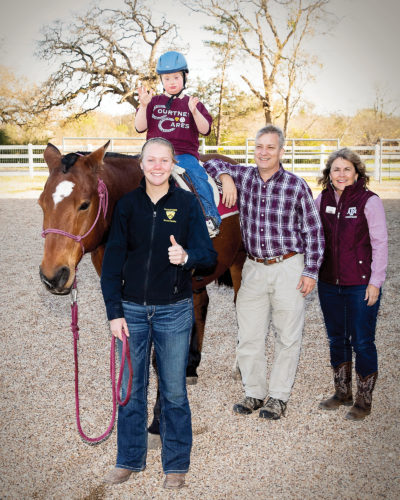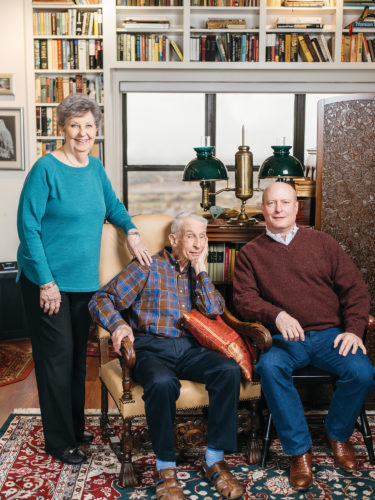The Magic of Horses
Texas A&M’s Equine Therapy Program is changing the lives of veterans and people with disabilities.
Story by Jeannie Ralston, Spirit Magazine, Texas A&M Foundation

The Courtney Cares program makes all the difference for 9-year-old Wyatt Branum (pictured to the right), who was born with Down Syndrome. In four years of riding, he’s made tremendous progress mentally and physically. While never reluctant to ride, he can now mount and dismount his horse Straw Flying Down, who happens to be a gift from Lyle Lovett ’79 to the Parsons Mounted Cavalry, with little assistance. He trots on the horse, centers himself when off balance in the saddle and listens with 100 percent attention to his instructors.
THE COURTNEY OF COURTNEY CARES
Courtney Grimshaw ’85 loved horses.
Growing up outside of Colorado Springs, she got her first horse in high school. When she was attending Texas A&M, she had an experience that sparked a dream for her: She helped a friend’s son, who had a debilitating disease, learn to ride.
“The child’s mother said it was the first time he did anything other kids could do,” said Dee Grimshaw, Courtney’s mother. “It was so rewarding for her.”
Seeing the change in the boy planted Courtney’s dream of someday having a horse camp for kids.
“She thought a horse could cure everything,” Dee continued. “Really that was the bottom line.”
But the idea of a camp was sidelined as Courtney, who was an animal science major at Texas A&M and earned an MBA in accounting from The University of Texas, built an impressive career in international finance—much of it spent in Kazakhstan as the tax partner for the global region of PricewaterhouseCoopers.
When she wasn’t negotiating business opportunities for the developing country, Courtney rode dressage horses, which she bought from a breeder in Poland. In 2010, after 12 years in Kazakhstan, she was preparing to return to Texas to live.
She built a home on acreage near the small town of Thorndale—between Austin and College Station—and started erecting a state-of-the-art horse barn, which would have been ideal for that children’s horseback riding camp she’d planned.
But, then, just months before leaving Kazakhstan, Courtney passed away unexpectedly at age 46, leaving her family and friends devastated.
“We felt a huge hole in our lives,” Dee said. “We had to do something for her, something to help people. That’s what she would do.”
Collectively, the Grimshaw family sold her property in Thorndale and used the funds to establish an equine therapy program at Texas A&M.
“We connected the dots and decided this would be an ideal way to honor her,” said Jim Grimshaw, Courtney’s younger brother. “This is our way of perpetuating her spirit and making something good come out of our terrible loss.”
Because Courtney was such a fervent Aggie, the family reached out to The Texas A&M University System.
“From the word ‘go’ all the pieces came together in a way that continues to surprise and delight us, especially since the program supports the values of Texas A&M—research, education, and service,” Jim said. “It seems like Courtney was guiding the process. Serendipity is the word that comes to mind when we talk about it. Things just seemed meant to be.”

THE PROGRAM
Launched in 2012 with $1.2 million from the sale of Courtney’s property, Courtney Cares was designed to do more than help local children, adults, and veterans in need of services. It was designed as a living, breathing, educational laboratory and classroom where students interested in volunteering could learn about the benefits and needs of the Equine Assisted Activities and Therapy industry.
Courtney Cares is operated through a strategic partnership with the Corps of Cadets’ Parsons Mounted Cavalry and Dr. Nancy Krenek’s therapy center, Ride On Center for Kids (ROCK), which provides professional instructors, licensed therapists, and more than 20 years of experience.
When Krenek was approached by the System in 2012 to head up this project, she knew that Texas A&M could be the catalyst for promoting excellence in this industry because of its high standards of service, education, and research.
Today, the program helps children, adults, and veterans experience the life-changing therapy of horses.
Currently, 15 to 20 of the Cavalry’s 66 horses are part of the program, and each horse is vetted by the standards of the Professional Association of Therapeutic Horsemanship.
“Our horses work well because they’re trained to trust their riders and ground handlers to keep them safe,” said Bob Byrns ’74, the Cavalry site manager. “Once horses have accepted the leadership relationship, they will do almost anything to please their leader.”
Courtney Cares supports the Cavalry’s budget by helping to pay for horse maintenance, renting Freeman Arena, and buying equipment such as saddles, helmets, and horse trailers. Texas A&M students—often from the health sciences, education, and animal science fields—serve as volunteer side walkers and horse handlers during Courtney Cares sessions.
Two types of sessions are offered at no charge for a couple hundred participants. The first is for children and adults with challenges that are either physical or emotional. The second is for veterans who are seeking to learn leadership through horsemanship as they adjust to their post-military life, often with physical injury or PTSD from their service.
“The movement of the horse provides a deep-pressure stimulus with each step,” explained Krenek. “The rider can receive 160 to 200 biofeedback impulses per minute in the neuromuscular system, the brain, the nerves, and the muscles. These impulses provide a calming effect on the nervous system that helps participants respond in a more proactive way to life. The cause-and-effect relationship with the horse also allows self-discovery and opportunities for leadership that aid in teaching horsemanship, appropriate behavior, and social skills.”

Equine Assisted Activities and Therapy is a growing field because of many studies that have demonstrated the ways horses help people improve physically and emotionally. “There are multifaceted opportunities for improvement,” said Dr. Jim Heird, executive director of the Equine Initiative at Texas A&M, a joint program between the College of Agriculture and Life Sciences and the College of Veterinary Medicine & Biomedical Sciences (CVM). “We know that the movement of the horse closely duplicates the movement of human walking. People can improve their core muscles and walking by riding a horse.”
As for emotional benefits, Dr. Priscilla Lightsey ’80, a physical therapist with Courtney Cares who is also a hippotherapy clinical specialist, explained one reason horses have such an impact.
“Participants have to communicate with the horse,” she said. “They have ownership and control of something 1,200 pounds. That’s powerful.”
“Horses are always looking for a leader,” added Heird.
This, he noted, helps children and those with disabilities gain confidence as they guide the animals. For veterans, taking care of a horse can make them feel whole.
“Veterans do the same tasks the cadets do for the horses, but at a slower pace,” Byrns said. “They have to modify their behavior to work with horses; they have to be calm and gentle. It really helps them handle their personal relationships with their kids and spouses better.”
A research study that included the Courtney Cares program documented a 74 percent decrease in PTSD symptoms and an 86.8 percent improvement in veterans’ overall mental health.
The fact that Courtney Cares would benefit military veterans made the Grimshaw family even more comfortable with the goals of the program.
Courtney’s father, the late James A. “Bo” Grimshaw, Ph.D., was a retired Texas A&M Regents Professor for Life and Texas A&M Commerce Professor Emeritus, as well as a retired Air Force lieutenant colonel. “It is powerful to see the list of outcomes for participants in the program, and that means a great deal to our family,” Bo said before he passed away in April 2018. “Courtney continues to have a positive effect on so many people. That is the legacy our family wants to perpetuate.”
###
Note: This story originally appeared in the 2019 Spring edition of CVM Today. This is a condensed version of The Magic of Horses. The original version was published in the Texas A&M Foundation’s Spirit magazine. You can read the full story at https://www.txamfoundation.com/Summer-2018/Cover-Feature.aspx.
For more information about the Texas A&M College of Veterinary Medicine & Biomedical Sciences, please visit our website at vetmed.tamu.edu or join us on Facebook, Instagram, and Twitter.
Contact Information: Jennifer Gauntt, Interim Director of Communications, Media & Public Relations, Texas A&M College of Veterinary Medicine & Biomedical Science; jgauntt@cvm.tamu.edu; 979-862-4216


